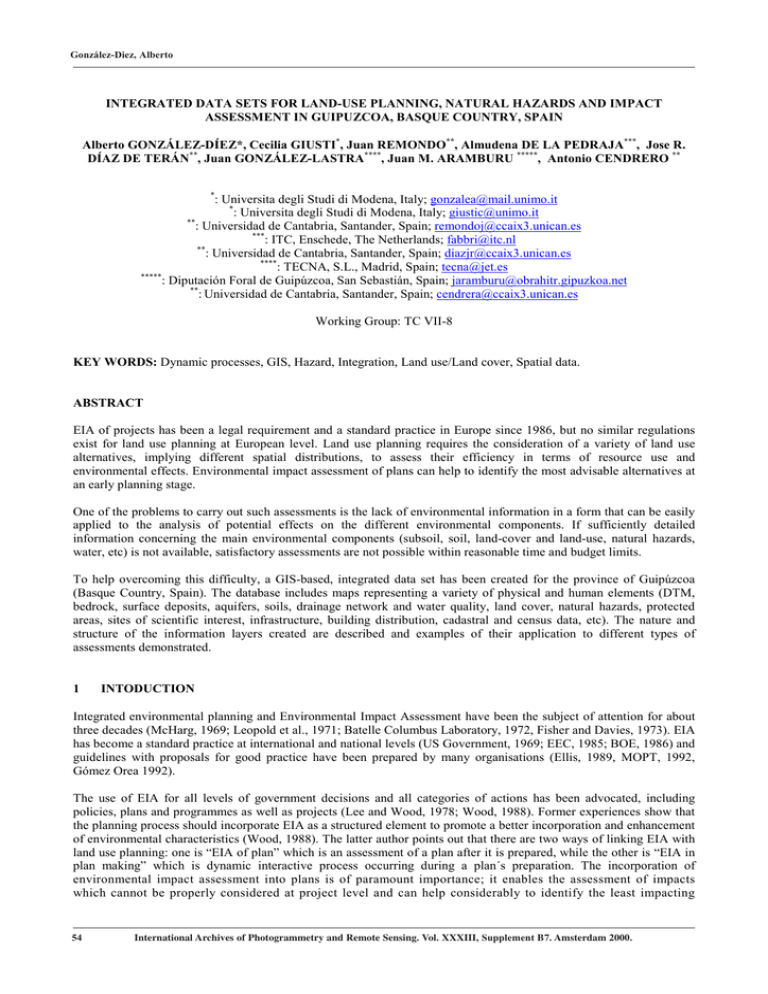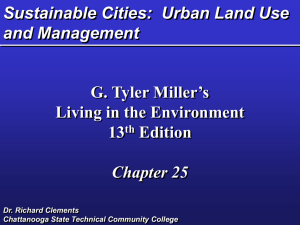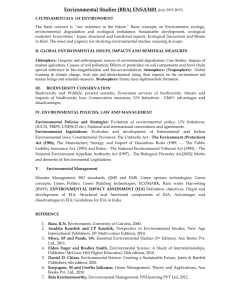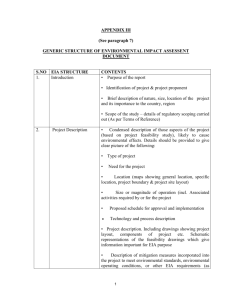INTEGRATED DATA SETS FOR LAND-USE PLANNING, NATURAL HAZARDS AND IMPACT
advertisement

González-Diez, Alberto INTEGRATED DATA SETS FOR LAND-USE PLANNING, NATURAL HAZARDS AND IMPACT ASSESSMENT IN GUIPUZCOA, BASQUE COUNTRY, SPAIN Alberto GONZÁLEZ-DÍEZ*, Cecilia GIUSTI*, Juan REMONDO**, Almudena DE LA PEDRAJA***, Jose R. DÍAZ DE TERÁN**, Juan GONZÁLEZ-LASTRA****, Juan M. ARAMBURU *****, Antonio CENDRERO ** * : Universita degli Studi di Modena, Italy; gonzalea@mail.unimo.it * : Universita degli Studi di Modena, Italy; giustic@unimo.it ** : Universidad de Cantabria, Santander, Spain; remondoj@ccaix3.unican.es *** : ITC, Enschede, The Netherlands; fabbri@itc.nl ** : Universidad de Cantabria, Santander, Spain; diazjr@ccaix3.unican.es **** : TECNA, S.L., Madrid, Spain; tecna@jet.es ***** : Diputación Foral de Guipúzcoa, San Sebastián, Spain; jaramburu@obrahitr.gipuzkoa.net ** : Universidad de Cantabria, Santander, Spain; cendrera@ccaix3.unican.es Working Group: TC VII-8 KEY WORDS: Dynamic processes, GIS, Hazard, Integration, Land use/Land cover, Spatial data. ABSTRACT EIA of projects has been a legal requirement and a standard practice in Europe since 1986, but no similar regulations exist for land use planning at European level. Land use planning requires the consideration of a variety of land use alternatives, implying different spatial distributions, to assess their efficiency in terms of resource use and environmental effects. Environmental impact assessment of plans can help to identify the most advisable alternatives at an early planning stage. One of the problems to carry out such assessments is the lack of environmental information in a form that can be easily applied to the analysis of potential effects on the different environmental components. If sufficiently detailed information concerning the main environmental components (subsoil, soil, land-cover and land-use, natural hazards, water, etc) is not available, satisfactory assessments are not possible within reasonable time and budget limits. To help overcoming this difficulty, a GIS-based, integrated data set has been created for the province of Guipúzcoa (Basque Country, Spain). The database includes maps representing a variety of physical and human elements (DTM, bedrock, surface deposits, aquifers, soils, drainage network and water quality, land cover, natural hazards, protected areas, sites of scientific interest, infrastructure, building distribution, cadastral and census data, etc). The nature and structure of the information layers created are described and examples of their application to different types of assessments demonstrated. 1 INTODUCTION Integrated environmental planning and Environmental Impact Assessment have been the subject of attention for about three decades (McHarg, 1969; Leopold et al., 1971; Batelle Columbus Laboratory, 1972, Fisher and Davies, 1973). EIA has become a standard practice at international and national levels (US Government, 1969; EEC, 1985; BOE, 1986) and guidelines with proposals for good practice have been prepared by many organisations (Ellis, 1989, MOPT, 1992, Gómez Orea 1992). The use of EIA for all levels of government decisions and all categories of actions has been advocated, including policies, plans and programmes as well as projects (Lee and Wood, 1978; Wood, 1988). Former experiences show that the planning process should incorporate EIA as a structured element to promote a better incorporation and enhancement of environmental characteristics (Wood, 1988). The latter author points out that there are two ways of linking EIA with land use planning: one is “EIA of plan” which is an assessment of a plan after it is prepared, while the other is “EIA in plan making” which is dynamic interactive process occurring during a plan´s preparation. The incorporation of environmental impact assessment into plans is of paramount importance; it enables the assessment of impacts which cannot be properly considered at project level and can help considerably to identify the least impacting 54 International Archives of Photogrammetry and Remote Sensing. Vol. XXXIII, Supplement B7. Amsterdam 2000. González-Diez, Alberto alternatives at pre-planning or planning stage. Although not required by EU directives, this type of assessment has become mandatory in some European countries and/or regions (Rivas et al., 1994). There are several reasons why land-use planning agencies in many countries have not adopted and implemented EIA procedures within the general planning process. One of these is the fact that planning laws have normally preceded environmental laws and established their own dynamics and operational procedures. Linked to this is the fact that most planners come from the field of public administration or architecture and are therefore not comfortable when it comes to gather, interpret and assess environmental information. Finally, planning agencies at municipal or higher levels of administration are not properly staffed by natural scientists. The net result of this is a general lack of an adequate information base on the natural environment when it comes to formulate land-use plans or carry out a variety of assessments related to environmental components and/or processes. A possible course of action to help overcoming the type of problems described would be the compilation of environmental information in a form which can be easily applied to the analysis of potential effects on the different environmental components. If sufficiently detailed information concerning the main environmental components (subsoil, soil, land-cover and land-use, natural hazards, water, etc.) is not available, satisfactory assessments are not possible within reasonable time and budget limits. This type of approach was initially tried in two provinces in northern Spain, using essentially manual overlay methods (Cendrero and Díaz de Terán, 1987; Cendrero et al., 1987); these methods, although adequate for solving certain assessment and planning problems, have limitations and lack versatility. Computed-assisted methods offer a clear possibility to complement and improve the above-mentioned approach. 2 THE CASE STUDY The case study presented here corresponds to the creation of a GIS-based integrated data set and its application to solve a variety of environmental assessment problems in the province of Guipúzcoa. Guipúzcoa, one of the three Basque provinces (Fig. 1) has 1997 km2, and about 700,000 inhabitants, highly concentrated in the coastal strip and along some valleys. It is an area of rugged relief in which flat areas (gradient <5%) represent less than a tenth of the territory. The climate is mild and humid (average annual temperature around 14ºC near the coast and rainfall around 12001500 mm). The geological and geomorphological nature of the province, together with climatic conditions and density of population make natural hazards (flooding, landsliding) an important environmental problem. 3 THE DATA SET Initial map preparation was carried out at the 1:25,000 scale, on the basis of air-photo interpretation and field surveys. In some cases the information was directly obtained from administration agencies or services. Thematic maps were digitised to construct the database. Independent alphanumeric identification codes were defined for each theme or element represented. The vectorial elements digitized (points, lines, polygons) were treated separately, subject to error-filtering and georeferenced; the initially defined alphanumeric codes were then assigned to each one. All vectorial elements of the same type for each theme were grouped into a single information layer. The three layers (points, lines polygons) were then linked to produce the different thematic maps. Vectorial maps were rasterized in order to carry out different overlays and combinations The database thus constructed includes maps representing a number of physical and human elements obtained from a variety of sources. There are three main groups of maps: Fig. 1. Location Map International Archives of Photogrammetry and Remote Sensing. Vol. XXXIII, Supplement B7. Amsterdam 2000. 55 González-Diez, Alberto DEM-derived maps: -slope aspect -slope gradient Descriptive maps: -Geological map -Geomorphology (it represents geological characteristics not included in other maps, including active processes) -Surface deposits (represents all un-consolidated materials except soils) -Regolith thickness -Foundation conditions (qualitative summary of geotechnical conditions) -Soil types and soil capability (descriptive representation of soil types and assessment of soil capability according to the FAO system) -Integrated morphodynamic units (“homogeneous” environmental units defined on the basis of field surveys, considering geomorphological, land cover and human activities characteristics) -Land cover -Landscape units (visual perception units defined in the field on the basis of landform and land cover) -Visual basins -Sites of geomorphological interest -Trees of special interest -Wells and springs -Stream-course quality (quality of stream-course sectors according to a rank defined by the provincial administration on the basis of a series of indicators) -Rainfall distribution -Population centers and built-up areas -Waste disposal sites -Municipal boundaries -Stream channel protection (protection status of stream courses and margins) -Protected natural areas (reflecting all areas subject to some type of protection norms) Derivative maps -Lithology (a simplification derived from the geological map) -Flood protection perimeters (derived from the map on geomorphology and natural hazards) -Protection perimeters for population centers (derived from the built-up areas and population centers map) -Land use recommendations (derived from maps on integrated morphodynamic units, soils and soils capability, land cover, geomorphology and foundation conditions) -Potential vegetation (derived from land cover, soils and topographic maps, through field survey and interpretation) -Aquifer vulnerability (derived from maps on geology, regolith thickness, soils and complementary information on aquifer distribution and depth) -Landfill suitability (derived from maps on geology, geomorphology, surface deposits, regolith thickness, land cover, drainage network and population centers). 1. 2. 3. 4. 5. 6. 7. 8. 9. 10. 11. 12. 13. 14. 15. 16. Wells and springs Excellent trees Visual basins Drainage network Protected natural areas Regolith thickness Slope aspect Surface deposits Geology Geomorphology Foundation conditions S.G.I. Lithology Municipal boundaries Population centers Landscape units 17. 18. 19. 20. 21. 22. 23. 24. 25. 26. 27. 28. 29. 30. 31. 32. Built-up areas Stream channel protection Slope gradient Flood protection perimeters Planning P.P.P.C. Land-use recommendations Soil capability Integral morphodynamic units Land cover Potential vegetation Stream course quality Waste disposal sites Aquifer vulnerability Rainfall Land-fill suitability Fig. 2. Thematic maps included in the data set. S.G.I. is Sites of Geomorphological Interest; P.P.P.C. is Protection Perimeters for Population Centers. 56 International Archives of Photogrammetry and Remote Sensing. Vol. XXXIII, Supplement B7. Amsterdam 2000. González-Diez, Alberto This set of digital maps, result of a collaborative effort between public administration, academia and private industry, has been conceived as a free-access database to be used mainly for land-use planning and environmental assessment of plans (at provincial and municipal levels), but can also be applied to EIA of projects (with some limitations, due to the difference in the scale of the analysis). The data set has been prepared using the GESPLAN software. Figure 2 shows the entry page, with the icons for the different thematic maps. 4 APPLICATIONS OF THE DATA SET The data set thus constructed can be used in a variety of ways: a) As a descriptive information medium (Figs. 3 and 4). Data can be retrieved for any of the data layers and desplayed as thematic maps, for visualisation or direct use. They can be obtained for the whole province, a municipality, a quadrangle, etc. These maps can be directly used for a variety of planning purposes, such as identification of certain sensitive natural systems (Fig. 3) or areas with rock or industrial mineral resources (Fig. 4). b) The maps can be combined by simple or weighted overlays, to obtain derivative maps which depict more complex environmental characteristics, such as the potential vegetation map, or the combination of certain planning or regulatory criteria with human and/or natural features (protection perimeters for stream population centers). courses or for c) For the assessment of capability and impact activities, for the design and/or assessment of land-use plans, master plans, etc. Attractiveness, vulnerability, capability, etc., for different activities can be defined using simple weighting/scaling methods which provide an integrated view of the carrying capacity or suitability of the territory to support those activities (Fig. 5). Fig. 3. Land cover map Integrated assessment maps are thus obtained. Examples of such maps are: “Land-use recommendations map” (Fig. 5a) obtained through the combination of the “Integrated environmental units map”, “Soils map”, “Land cover map” and “Foundation conditions map”, through the application of a series of clearly defined criteria which establish the type of farming and forestry activities that are considered most advisable as well as limitations due to natural hazards or foundation conditions; “Protection perimeters for population centers” (Fig. 5b), representing areas in which certain types of activities must be restricted (derived from the population centers and built-up areas maps). Fig. 4. Geological map International Archives of Photogrammetry and Remote Sensing. Vol. XXXIII, Supplement B7. Amsterdam 2000. 57 González-Diez, Alberto d) Application to EIA of projects. The data set described above is a potentially useful basis for EIA studies in the province. Nevertheless, as the database is conceived as a general one adaptations will normally be necessary, because some relevant information for certain projects will not be available, or will not have sufficient detail. One of the aims of the GETS case study in the province is to determine to what extent the database has to be improved and completed to be used for EIA of projects of transportation infrastructures Two examples illustrate some of the improvements needed. Analysis of landscape impacts are based essentially on landform, land cover and land use characteristics. The latter two have needed relatively small improvements (updating, better definition and mapping in certain areas). However, the former did not have sufficient resolution to properly include the new topography represented by a motorway, which is the basis to assess magnitude and intensity of impacts (Fig. 6). Fig. 5. Examples of derived maps obtained through simple or weighted overlays Fig. 6. Example of modified DTM including the new infraestructure Analysis of impacts on slope processes. This analysis must be based on a detailed knowledge of the distribution, type and age of former slope movements. The use of SDA techniques, correlating such past instabilities with different conditioning factors is used to assess landslide susceptibility and impact (Remondo et al., this volume). Fig. 7. Comparison between original (a) and modified (b) maps of past landslides 58 International Archives of Photogrammetry and Remote Sensing. Vol. XXXIII, Supplement B7. Amsterdam 2000. González-Diez, Alberto The existing database did not have sufficiently detailed information on slope movements and new maps had to compiled through field work and air-photo interpretation (Fig. 7). 5 CONCLUSIONS General digital databases as the one described are a useful data source for a variety of environmental studies. Application of these databases to specific impact studies normally requires adaptation and updating of information and export to other systems. The development of GIS tools for EIA which incorporate and normalise existing databases for a given territory can considerably simplify and improve future analyses. ACKNOWLEDGEMENTS This work was carried out as part of the GETS project [Contract FMRX-CT98-0162 (DG12-SLJE), TMR programme, European Commission]. REFERENCES Batelle Columbus Laboratory, 1972. Environmental evaluation system for water resource planning. Batelle Columbus Laboratory, Springfield. BOE, 1986. Real Decreto 1302/1986 sobre Evaluación de impacto ambiental, 28 June, Boletín Oficial del Estado, Madrid. Cendrero, A., Díaz de Terán, J.R. 1987. The environmental map system of the University of Cantabria, Spain. In: P. Arndt and G. Lüttig (Eds.), Mineral Resources Extraction, Environmental Protection and Land-use Planning in the Industrial and Developing Countries, E. Schweizerbat Verlag, Stuttgart, pp. 149-181. Cendrero, A., Díaz de Terán, J.R., Fernández, E., Garrote, R., Gonzalez Lastra, J.R., Inoriza, I., Lüttig, G., Otamendi, J., Pérez, M., Serrano, A. 1987. Detailed geological hazards mapping for urban and rural planning in Vizcaya, Nortern Spain. In: Geology for Environmental Planning. F. Ch. Wolf (Ed.), Geological Survey of Norway, Special Publication, 2: pp. 25-41 Ellis, D., 1989. Environments at Risk: Case Histories of Impacts Assessments, Springer, Heidelberg. EEC, 1985. Environmental impact assessment, Directive 85/337/ECC, 27 June, European Economic Community, Brussels. Fischer, D.W. Davies, G.S., 1973. An approach to assessing environmental impacts, Journal of Environmental Management, 1(1), pp. 207-227. Gómez Orea, D., 1992. Evaluación de Impacto Ambiental, Agrícola Española, S.A., Madrid. Lee, N., Wood, C., 1978. EIA: a European perspective, Built Environment, 4, pp. 101-110. Leopold, L.B., Clark, F.E., Hanshaw, B.B., Balsley J.R., 1971. A procedure for evaluating environmental impact. US Geological Survey Circular 645. McHarg, I.L., 1969. Design with Nature, Natural History Press, New York. MOPT, 1992. Guías Metodológicas Para la Elaboración de Estudios de Impacto Ambiental, 4, Aeropuertos, Ministerio de Obras Públicas y Urbanismo, Madrid. Remondo, J., González-Díez, A., Díaz de Terán, J.R., Cendrero, A.,Chung, C.J., Fabbri, A. 2000. Spatial data analysis for the assessment of slope instability; application to EIA for a case study in the Vergara-Eibar area, Guipúzcoa, Spain. IAPRS, Vol. XXXIII, Amsterdam. Rivas, V., González-Díez, A., Fischer, D.W., Cendrero, A., 1994. Journal of Environmental Planning and Management, 37, (3), pp. 305-322. International Archives of Photogrammetry and Remote Sensing. Vol. XXXIII, Supplement B7. Amsterdam 2000. 59 González-Diez, Alberto US Goverment, 1969. National Environmental Policy Act, 31 December, Washington, DC. Wood, C., 1988. EIA in plan making. In: P. Wathern (Ed.) Environmental Impact Assessment: Theory and Practice, Unwin Hyman, London. 60 International Archives of Photogrammetry and Remote Sensing. Vol. XXXIII, Supplement B7. Amsterdam 2000.







